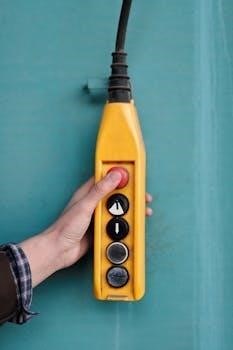Pure Chlor Salt System Manual⁚ A Comprehensive Guide
Welcome to the comprehensive guide for your Pure Chlor Salt System! This manual provides essential information for operating, installing, maintaining, and troubleshooting your system. Ensure proper usage and safety by reading and understanding this guide thoroughly before starting.
The Pure Chlor Salt System offers an efficient and user-friendly alternative to traditional chlorine methods for pool sanitation. Designed for ease of use, this system simplifies pool maintenance while ensuring clean and safe water for swimming. With built-in cell and power supply protections, Pure Chlor systems stand out for their reliability and extended warranties.
This system utilizes a natural process, converting common salt (sodium chloride) into chlorine through electrolysis. This eliminates the need for purchasing, handling, and storing conventional chlorine products. Pure Chlor systems are engineered to operate optimally within a salt level of 3500 to 4500 ppm, ensuring efficient chlorine generation. The system’s advanced features and protections make it a leading choice for maintaining pristine pool conditions.
Pure Chlor systems are manufactured in the USA by Solaxx, a company with a proven track record in producing high-quality chlorine generators. With over 100,000 pools and spas benefiting from Solaxx sanitation technology, Pure Chlor systems provide peace of mind and a hassle-free pool experience. This manual will guide you through the installation, operation, and maintenance of your Pure Chlor system, ensuring years of reliable performance.
Understanding Salt Chlorination Process
Salt chlorination, the core of the Pure Chlor system, is a natural and efficient method for sanitizing your pool water. The process begins with the addition of common salt (sodium chloride) to your pool. Once the salt is dissolved, the Pure Chlor system takes over, converting the salt into chlorine through a process called electrolysis.
Inside the system’s salt cell, an electric current passes through the saltwater, breaking down the sodium chloride molecules. This process generates chlorine gas, which dissolves in the water to form hypochlorous acid (HOCl) and hypochlorite ions (OCl-), the same sanitizing agents produced by traditional chlorine products. These compounds effectively kill bacteria, algae, and other contaminants, keeping your pool water clean and healthy.
One of the key advantages of salt chlorination is that the chlorine is continuously regenerated. As the chlorine disinfects the pool water, it eventually reverts back into salt, which is then recycled through the system. This closed-loop process minimizes the need for adding additional chemicals, resulting in a more stable and consistent chlorine level. Maintaining the correct salt level, typically between 3500 and 4500 ppm, is crucial for optimal system performance.
Key Components of the Pure Chlor System
The Pure Chlor Salt System comprises several essential components working in harmony to ensure effective pool sanitization. Understanding these components is crucial for proper operation and maintenance.
The primary component is the Salt Cell, where electrolysis occurs. This cell contains specially coated titanium plates that facilitate the conversion of salt into chlorine. The cell’s lifespan depends on usage and water chemistry, requiring periodic cleaning and eventual replacement.
Next is the Power Supply Unit (PSU), the brains of the system. The PSU provides the necessary electrical current to the salt cell, driving the electrolysis process. It also houses the system’s control panel, allowing you to adjust chlorine output and monitor system performance.
A Flow Sensor is another critical component, ensuring adequate water flow through the salt cell. This sensor prevents the system from operating without sufficient water, protecting the cell from damage; Many systems also include a Control Panel Display, providing real-time information about salt levels, water temperature, and system status. These components collectively contribute to the efficient and reliable operation of the Pure Chlor system.
Installation Guide for Pure Chlor Systems
Proper installation is paramount for the optimal performance and longevity of your Pure Chlor Salt System. Before commencing, ensure you have all necessary tools and materials, including plumbing fittings, electrical wiring, and a grounding rod. Always adhere to local electrical and plumbing codes.
Begin by selecting a suitable location for the power supply unit. It should be within a reasonable distance of the pool equipment and protected from direct sunlight and moisture. Mount the PSU securely to a wall or stable surface.
Next, install the salt cell in the return line to the pool, downstream from the filter and heater. Ensure proper water flow direction through the cell. Use appropriate plumbing fittings to create watertight connections. A flow sensor should be installed before the cell to prevent operation without adequate water flow.
Connect the power supply unit to the salt cell and flow sensor, following the wiring diagram provided. Ground the system properly to prevent electrical hazards. Finally, test the system after installation to ensure proper operation and chlorine production. It may take up to 24 hours for the salt to dissolve completely after adding.
Operating Your Pure Chlor System⁚ Step-by-Step
Operating your Pure Chlor system is straightforward. First, ensure the salt level in your pool is within the recommended range of 3500-4500 ppm. Add granulated pool salt as needed, allowing up to 24 hours for it to dissolve completely. Avoid iodized salt or salt with anti-caking agents.

Turn on the power supply unit. The system will automatically begin generating chlorine based on the set output percentage. Adjust the output level to achieve the desired chlorine residual in your pool water, typically between 1-3 ppm. Monitor chlorine levels regularly using a test kit or strips.
The system features a digital display showing salt level, water temperature, and chlorine output. Use the control buttons to adjust settings and view system information. The system may automatically shut down if salt levels are too low or high, or if there is insufficient water flow.
For optimal performance, allow the system to run during the pool’s filtration cycle. Adjust the output percentage based on bather load, weather conditions, and pool usage to maintain consistent chlorine levels. Regularly inspect the salt cell for scaling or debris buildup.
Maintaining Optimal Salt Levels (3500-4500 ppm)
Maintaining the correct salt level is crucial for the efficient operation of your Pure Chlor system. The ideal range is between 3500 and 4500 ppm (parts per million). Operating outside this range can reduce chlorine production, damage the salt cell, or trigger error codes. Regularly test your pool water using a salt test kit or strips to monitor the salt concentration.
If the salt level is too low, gradually add granulated pool salt directly to the pool. Calculate the required amount based on your pool’s volume and current salt level. Allow sufficient time for the salt to dissolve, typically up to 24 hours, before retesting. Distribute the salt evenly around the pool to promote faster dissolution.
If the salt level is too high, partially drain the pool and refill it with fresh water to dilute the salt concentration. Retest the water after refilling to ensure the salt level is within the recommended range. Avoid using iodized salt or salt with additives, as these can interfere with the chlorination process and potentially damage the system.
Consistent monitoring and adjustment of salt levels will ensure optimal performance, extend the lifespan of your salt cell, and maintain clean, sanitized pool water.
Troubleshooting Common Issues⁚ System Error Light

The dreaded “System Error” light on your Pure Chlor system can indicate various underlying problems. When this light illuminates, it signifies that the system has detected an anomaly that requires attention. Begin troubleshooting by first checking the basics⁚ ensure the power supply is properly connected and receiving power.
Next, inspect the salt cell for any visible signs of damage or excessive buildup. A dirty cell can impede chlorine production and trigger an error. Check the salt level in your pool water; insufficient salt is a common cause. Verify that the flow sensor is functioning correctly, as inadequate water flow can also lead to a system error.
If the salt level and flow are within acceptable ranges, try resetting the system by turning it off and then back on. This simple step can sometimes clear temporary errors. If the error persists, consult the error code section of this manual for specific guidance. In some cases, a more thorough inspection of the system’s components may be necessary, potentially requiring assistance from a qualified technician. Remember to always prioritize safety when troubleshooting electrical equipment.
Cleaning the Salt Cell⁚ Muriatic Acid Solution

Over time, calcium and mineral deposits can accumulate on the salt cell of your Pure Chlor system, hindering its ability to efficiently generate chlorine. Regular cleaning is essential to maintain optimal performance. A muriatic acid solution is commonly used for this purpose, but it must be handled with caution.
Before you begin, ensure you have appropriate safety gear⁚ gloves, eye protection, and a well-ventilated workspace. Prepare a cleaning solution by mixing one part muriatic acid with four parts water in a plastic container. Never add water to acid; always add acid to water to avoid dangerous splashing. Carefully submerge the salt cell in the solution, ensuring that only the plates are immersed.

Allow the cell to soak for approximately 5-10 minutes, or until the bubbling action ceases, indicating that the deposits are dissolving. Avoid prolonged soaking, as it can damage the cell. Once cleaned, thoroughly rinse the cell with fresh water before reinstalling it in your system. Regular cleaning, typically every 3-6 months, will extend the life of your salt cell and ensure consistent chlorine production.
Understanding and Addressing Low Salt Light Flashing
A flashing “Low Salt” light on your Pure Chlor system indicates that the salt concentration in your pool water is below the recommended level of 3500-4500 ppm. This is a crucial warning sign, as insufficient salt prevents the system from effectively generating chlorine, leading to inadequate sanitation.
The first step is to manually test your pool water’s salt level using a reliable testing kit or strips; Compare the result with the ideal range. If the salt level is indeed low, calculate the amount of salt needed to reach the optimal concentration, considering your pool’s volume. Gradually add granulated pool salt, ensuring it’s evenly distributed. Avoid using iodized salt or salt with anti-caking agents.
After adding salt, allow at least 24 hours for it to dissolve completely and re-test the water. If the “Low Salt” light persists despite adding salt, the salt cell may require cleaning or there might be an issue with the system’s sensor. Inspect the cell for mineral buildup and clean it if necessary, following the instructions in the cleaning section. If problems continue, consult the troubleshooting guide or contact customer support.
Pure Chlor System Error Codes and Solutions
The Pure Chlor system uses error codes to communicate potential issues that may arise during operation. Understanding these codes is crucial for efficient troubleshooting and maintaining optimal performance. When an error occurs, the system will display a specific code, often accompanied by an indicator light.
Consult the error code table in this manual to identify the meaning of the displayed code. Common error codes relate to low salt levels, high salt levels, cell malfunction, flow issues, or power supply problems. The table provides suggested solutions for each error, ranging from simple fixes like adjusting salt levels to more complex procedures like cleaning the cell or contacting technical support.
Before attempting any repairs, always disconnect the power supply to the system. Follow the recommended solutions carefully and, if unsure, seek assistance from a qualified technician. Ignoring error codes can lead to further damage to the system and compromise its ability to properly sanitize your pool water. Regular monitoring and prompt attention to error codes will ensure the longevity and efficiency of your Pure Chlor system.
Warranty Information and Support
Your Pure Chlor salt system is backed by a comprehensive warranty, offering peace of mind and protection against manufacturing defects. The specific terms and duration of the warranty may vary depending on the model and date of purchase. Please refer to the warranty card included with your system or visit our website for detailed information.
The warranty typically covers defects in materials and workmanship under normal use. It does not cover damage caused by improper installation, misuse, neglect, or unauthorized repairs. To ensure your warranty remains valid, it is essential to follow the installation and operating instructions outlined in this manual.
For technical support, troubleshooting assistance, or warranty claims, please contact our customer service department. Our knowledgeable representatives are available to answer your questions and provide guidance. You can reach us by phone, email, or through our online support portal. When contacting support, please have your model number, serial number, and proof of purchase readily available. We are committed to providing prompt and efficient support to ensure your complete satisfaction with your Pure Chlor system.
Safety Precautions and Guidelines
Prioritize safety when operating and maintaining your Pure Chlor salt system. Always disconnect the power supply before performing any maintenance or repairs. Ensure the area around the system is dry and free from obstructions.
When handling chemicals, such as muriatic acid for cleaning the salt cell, wear appropriate protective gear, including gloves, eye protection, and a respirator if necessary. Work in a well-ventilated area to avoid inhaling fumes. Never mix muriatic acid with other chemicals, as this could create hazardous reactions.
Keep children and pets away from the system and chemicals at all times. Store chemicals in a secure location, out of reach of children. If any chemical comes into contact with skin or eyes, flush immediately with plenty of water and seek medical attention.
Regularly inspect the system for leaks or damage. If you notice any issues, such as frayed wires or corroded components, contact a qualified technician for repair; Do not attempt to repair electrical components yourself unless you are a qualified electrician. By following these safety precautions, you can ensure a safe and enjoyable pool experience with your Pure Chlor system.

